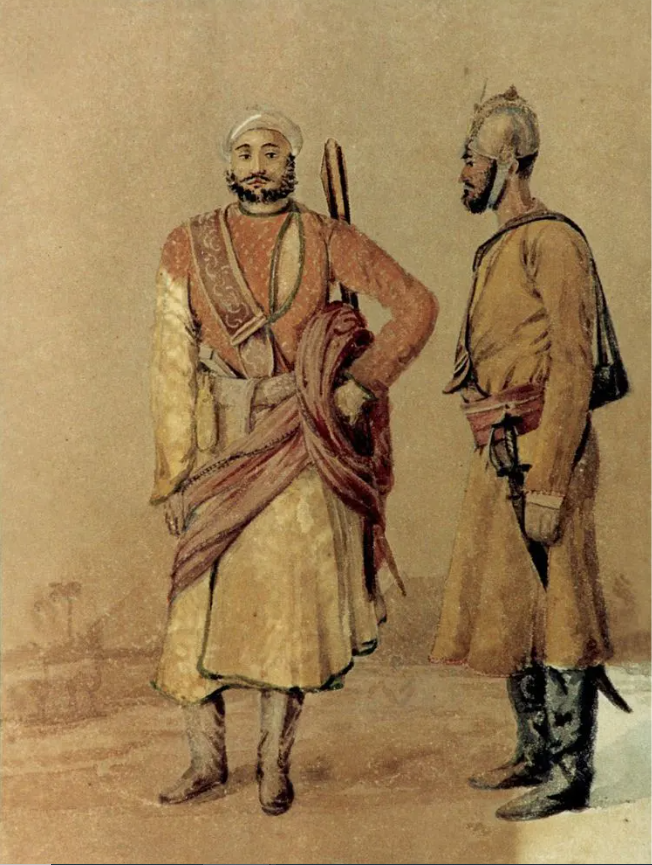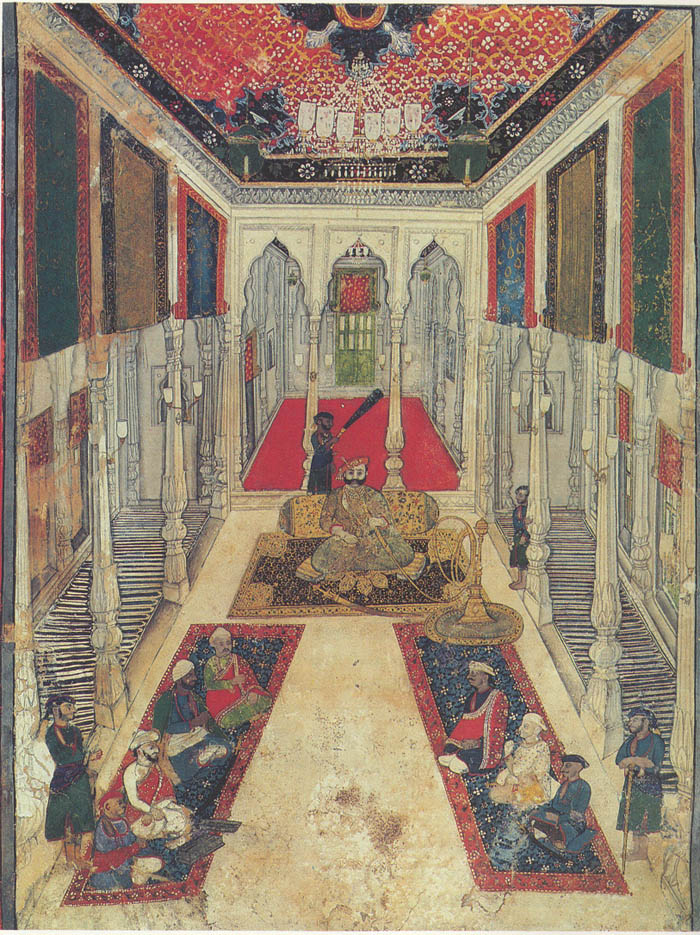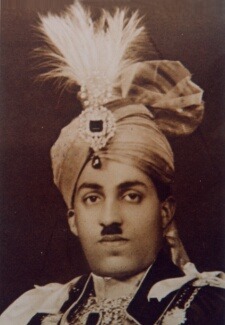|
Mansabdar
The Mansabdar was a military unit within the administrative system of the Mughal Empire introduced by Akbar. The word ''mansab'' is of Arabic origin meaning rank or position. The system determined the rank and status of a government official and military generals. Every civil and military officer was given a mansab, which determined their salaries & allowances. The term manasabadar means a person having a mansab. (which means a role) In the mansabdari system founded by Akbar, the mansabdars were military commanders, high civil and military officers, and provincial governors. Those mansabdars whose rank was one thousand or below were called Amir, while those above 1,000 were called Amir-al Kabir (Great Amir). Some great Amirs whose ranks were above 5,000 were also given the title of Amir-al Umara (Amir of Amirs). It was a system whereby nobles were granted the rights to hold a jagir, or revenue assignment (not land itself), for services rendered by them, with the direct control o ... [...More Info...] [...Related Items...] OR: [Wikipedia] [Google] [Baidu] |
Feudalism In Pakistan
Feudalism in contemporary Pakistan ( ur, ''zamīndāri nizam'') usually refers to the power and influence of large landowning families, particularly through very large estates and in more remote areas.Nicholas D. Kristof "Feudalism in Pakistan" ''The New York Times'', 1 August 2009, accessed: 7 February 2015 The adjective "feudal" in the context of Pakistan has been used to mean "a relatively small group of politically active and powerful landowners". "Feudal attitude" refers to "a combination of arrogance and entitlement". According to the Pakistan Institute of Labor Education and Research (PILER), five percent of agricultural households in Pakistan own nearly two-thirds of Pakistan's farmland. Large joint families in Pakistan may possess hundreds or even thousands of acres of land, while making little or no direct contribution to agricultural production, which is handled by "peasants or tenants who live at subsistence level". Landlord power may be based on control over loc ... [...More Info...] [...Related Items...] OR: [Wikipedia] [Google] [Baidu] |
Mughal Empire
The Mughal Empire was an early-modern empire that controlled much of South Asia between the 16th and 19th centuries. Quote: "Although the first two Timurid emperors and many of their noblemen were recent migrants to the subcontinent, the dynasty and the empire itself became indisputably Indian. The interests and futures of all concerned were in India, not in ancestral homelands in the Middle East or Central Asia. Furthermore, the Mughal empire emerged from the Indian historical experience. It was the end product of a millennium of Muslim conquest, colonization, and state-building in the Indian subcontinent." For some two hundred years, the empire stretched from the outer fringes of the Indus river basin in the west, northern Afghanistan in the northwest, and Kashmir in the north, to the highlands of present-day Assam and Bangladesh in the east, and the uplands of the Deccan Plateau in South India. Quote: "The realm so defined and governed was a vast territory of some , ra ... [...More Info...] [...Related Items...] OR: [Wikipedia] [Google] [Baidu] |
Government Of The Mughal Empire
The government of the Mughal Empire was a highly centralised bureaucracy, most of which was instituted during the rule of the third Mughal emperor, Akbar. The central government was headed by the Mughal emperor; immediately beneath him were four ministries. The finance/revenue ministry was responsible for controlling revenues from the empire's territories, calculating tax revenues, and using this information to distribute assignments. The ministry of the military (army/intelligence) was headed by an official titled ''mir bakhshi'', who was in charge of military organisation, messenger service, and the ''mansabdari'' system. The ministry in charge of law/religious patronage was the responsibility of the ''sadr as-sudr,'' who appointed judges and managed charities and stipends. Another ministry was dedicated to the imperial household and public works. Provinces The empire was divided into a number of ''subahs'' (provinces), each of which was headed by a provincial governor call ... [...More Info...] [...Related Items...] OR: [Wikipedia] [Google] [Baidu] |
Indian Subcontinent
The Indian subcontinent is a physiographical region in Southern Asia. It is situated on the Indian Plate, projecting southwards into the Indian Ocean from the Himalayas. Geopolitically, it includes the countries of Bangladesh, Bhutan, India, Maldives, Nepal, Pakistan, and Sri Lanka."Indian subcontinent". '' New Oxford Dictionary of English'' () New York: Oxford University Press, 2001; p. 929: "the part of Asia south of the Himalayas which forms a peninsula extending into the Indian Ocean, between the Arabian Sea and the Bay of Bengal. Historically forming the whole territory of Greater India, the region is now divided into three countries named Bangladesh, India and Pakistan." The terms ''Indian subcontinent'' and ''South Asia'' are often used interchangeably to denote the region, although the geopolitical term of South Asia frequently includes Afghanistan, which may otherwise be classified as Central Asian.John McLeod, The history of India', page 1, Greenwood Publishing ... [...More Info...] [...Related Items...] OR: [Wikipedia] [Google] [Baidu] |
Titles In Bangladesh
A title is one or more words used before or after a person's name, in certain contexts. It may signify either generation, an official position, or a professional or academic qualification. In some languages, titles may be inserted between the first and last name (for example, ''Graf'' in German, Cardinal in Catholic usage (Richard Cardinal Cushing) or clerical titles such as Archbishop). Some titles are hereditary. Types Titles include: * Honorific titles or styles of address, a phrase used to convey respect to the recipient of a communication, or to recognize an attribute such as: ** Imperial, royal and noble ranks ** Academic degree ** Social titles, prevalent among certain sections of society due to historic or other reasons. ** Other accomplishment, as with a title of honor * Title of authority, an identifier that specifies the office or position held by an official Titles in English-speaking areas Common titles * Mr. – Adult man (regardless of marital status) * Ms. ... [...More Info...] [...Related Items...] OR: [Wikipedia] [Google] [Baidu] |
Titles In India
A title is one or more words used before or after a person's name, in certain contexts. It may signify either generation, an official position, or a professional or academic qualification. In some languages, titles may be inserted between the first and last name (for example, ''Graf'' in German, Cardinal in Catholic usage ( Richard Cardinal Cushing) or clerical titles such as Archbishop). Some titles are hereditary. Types Titles include: * Honorific titles or styles of address, a phrase used to convey respect to the recipient of a communication, or to recognize an attribute such as: ** Imperial, royal and noble ranks ** Academic degree ** Social titles, prevalent among certain sections of society due to historic or other reasons. ** Other accomplishment, as with a title of honor * Title of authority, an identifier that specifies the office or position held by an official Titles in English-speaking areas Common titles * Mr. – Adult man (regardless of marital s ... [...More Info...] [...Related Items...] OR: [Wikipedia] [Google] [Baidu] |
Feudalism In Asia
Feudalism, also known as the feudal system, was the combination of the legal, economic, military, cultural and political customs that flourished in medieval Europe between the 9th and 15th centuries. Broadly defined, it was a way of structuring society around relationships that were derived from the holding of land in exchange for service or labour. Although it is derived from the Latin word ''feodum'' or ''feudum'' (fief), which was used during the Medieval period, the term ''feudalism'' and the system which it describes were not conceived of as a formal political system by the people who lived during the Middle Ages. The classic definition, by François Louis Ganshof (1944),François Louis Ganshof (1944). ''Qu'est-ce que la féodalité''. Translated into English by Philip Grierson as ''Feudalism'', with a foreword by F. M. Stenton, 1st ed.: New York and London, 1952; 2nd ed: 1961; 3rd ed.: 1976. describes a set of reciprocal legal and military obligations which existed amon ... [...More Info...] [...Related Items...] OR: [Wikipedia] [Google] [Baidu] |
Routledge
Routledge () is a British multinational publisher. It was founded in 1836 by George Routledge, and specialises in providing academic books, journals and online resources in the fields of the humanities, behavioural science, education, law, and social science. The company publishes approximately 1,800 journals and 5,000 new books each year and their backlist encompasses over 70,000 titles. Routledge is claimed to be the largest global academic publisher within humanities and social sciences. In 1998, Routledge became a subdivision and imprint of its former rival, Taylor & Francis Group (T&F), as a result of a £90-million acquisition deal from Cinven, a venture capital group which had purchased it two years previously for £25 million. Following the merger of Informa and T&F in 2004, Routledge became a publishing unit and major imprint within the Informa "academic publishing" division. Routledge is headquartered in the main T&F office in Milton Park, Abingdon, Oxfordshir ... [...More Info...] [...Related Items...] OR: [Wikipedia] [Google] [Baidu] |
Asiatic Society Of Bangladesh
The Asiatic Society of Bangladesh is a non political and non profit research organisation registered under both Society Act of 1864 and NGO Bureau, Government of Bangladesh. The Asiatic Society of Bangladesh was established as the Asiatic Society of East Pakistan in Dhaka in 1952 by a number of Muslim leaders, and renamed in 1972. Ahmed Hasan Dani, a noted Muslim historian and archaeologist of Pakistan played an important role in founding this society. He was assisted by Muhammad Shahidullah, a Bengali linguist. The society is housed in Nimtali, walking distance from the Curzon Hall of Dhaka University, locality of Old Dhaka. Publications The society's publications include: * ''Banglapedia, the National Encyclopedia of Bangladesh'' (edition 2, 2012) * ''Encyclopedia of Flora and Fauna of Bangladesh'' (2010, 28 volumes) * ''Cultural Survey of Bangladesh, a documentation of the country's cultural history, tradition and heritage'' (2008, 12 volumes) * ''Children’s Banglapedia' ... [...More Info...] [...Related Items...] OR: [Wikipedia] [Google] [Baidu] |
Jagir
A jagir ( fa, , translit=Jāgir), also spelled as jageer, was a type of feudal land grant in the Indian subcontinent at the foundation of its Jagirdar (Zamindar) system. It developed during the Islamic rule era of the Indian subcontinent, starting in the early 13th century, wherein the powers to govern and collect tax from an estate was granted to an appointee of the state.Jāgīrdār system: INDIAN TAX SYSTEM Encyclopædia Britannica (2009) The tenants were considered to be in the servitude of the jagirdar. There were two forms of jagir, one being conditional and the other unconditional. The conditional jagir required the governing family to maintain troops and provide their service to the state when asked. The land grant w ... [...More Info...] [...Related Items...] OR: [Wikipedia] [Google] [Baidu] |
Nawab
Nawab (Balochi: نواب; ar, نواب; bn, নবাব/নওয়াব; hi, नवाब; Punjabi : ਨਵਾਬ; Persian, Punjabi , Sindhi, Urdu: ), also spelled Nawaab, Navaab, Navab, Nowab, Nabob, Nawaabshah, Nawabshah or Nobab, is a Royal title indicating a sovereign ruler, often of a South Asian state, in many ways comparable to the western title of Prince. The relationship of a Nawab to the Emperor of India has been compared to that of the Kings of Saxony to the German Emperor. In earlier times the title was ratified and bestowed by the reigning Mughal emperor to semi-autonomous Muslim rulers of subdivisions or princely states in the Indian subcontinent loyal to the Mughal Empire, for example the Nawabs of Bengal. The title is common among Muslim rulers of South Asia as an equivalent to the title Maharaja. "Nawab" usually refers to males and literally means ''Viceroy''; the female equivalent is " Begum" or "''Nawab Begum''". The primary duty of a Nawab wa ... [...More Info...] [...Related Items...] OR: [Wikipedia] [Google] [Baidu] |
Hyder Ali
Hyder Ali ( حیدر علی, ''Haidarālī''; 1720 – 7 December 1782) was the Sultan and ''de facto'' ruler of the Kingdom of Mysore in southern India. Born as Hyder Ali, he distinguished himself as a soldier, eventually drawing the attention of Mysore's rulers. Rising to the post of Dalavayi ( commander-in-chief) to Krishnaraja Wodeyar II, he came to dominate the titular monarch and the Mysore government. He became the de facto ruler of Mysore as Sarvadhikari (Chief Minister) by 1761. During intermittent conflicts against the East India Company during the First and Second Anglo–Mysore Wars, Hyder Ali was the military leader. Though illiterate, Hyder Ali concluded an alliance with the French, and used the services of French workmen in raising his artillery and arsenal. His rule of Mysore was characterised by frequent warfare with his neighbours and rebellion within his territories. This was not unusual for the time as much of the Indian subcontinent was then in ... [...More Info...] [...Related Items...] OR: [Wikipedia] [Google] [Baidu] |






_from_Court_Game_of_Geography_MET_DP862917.jpg)